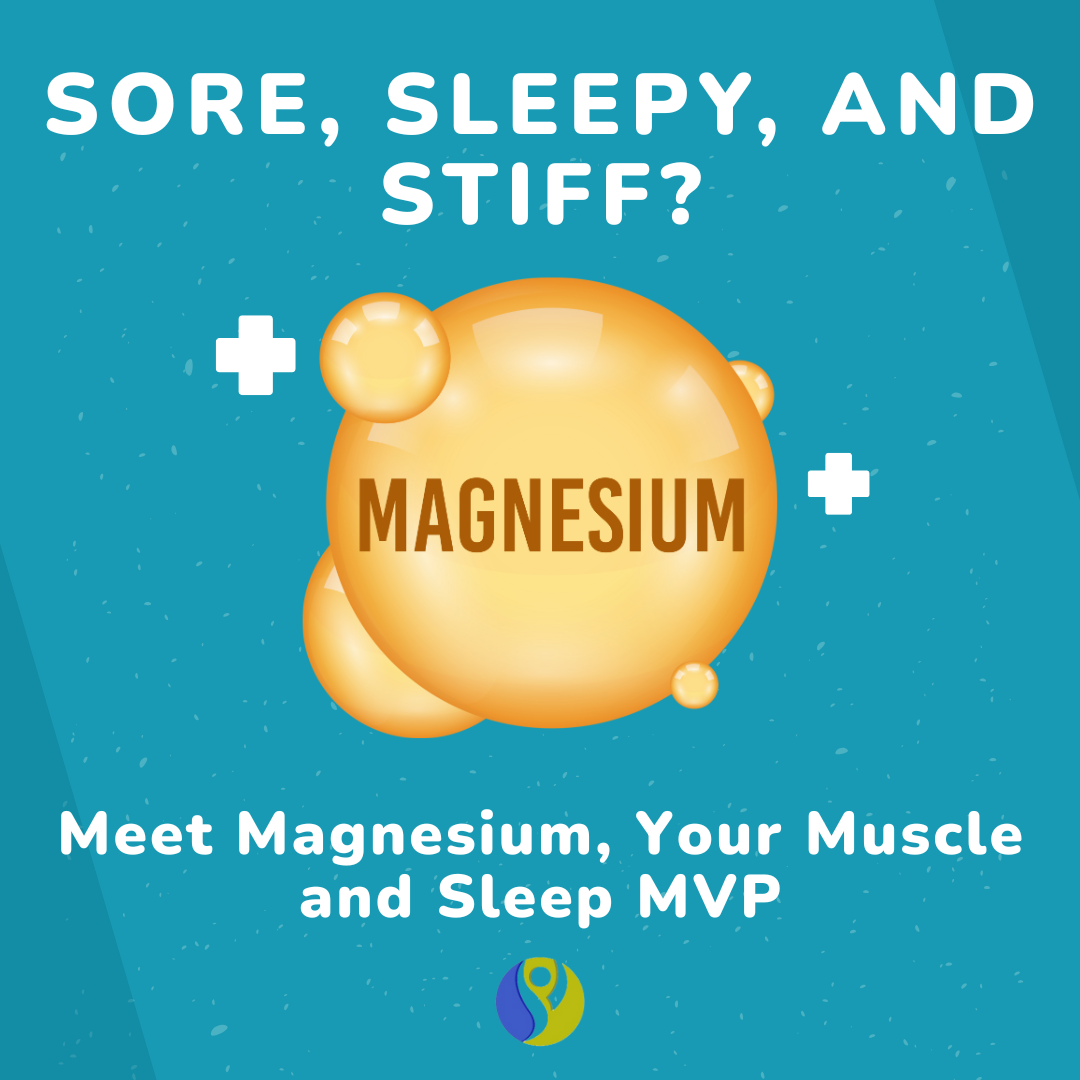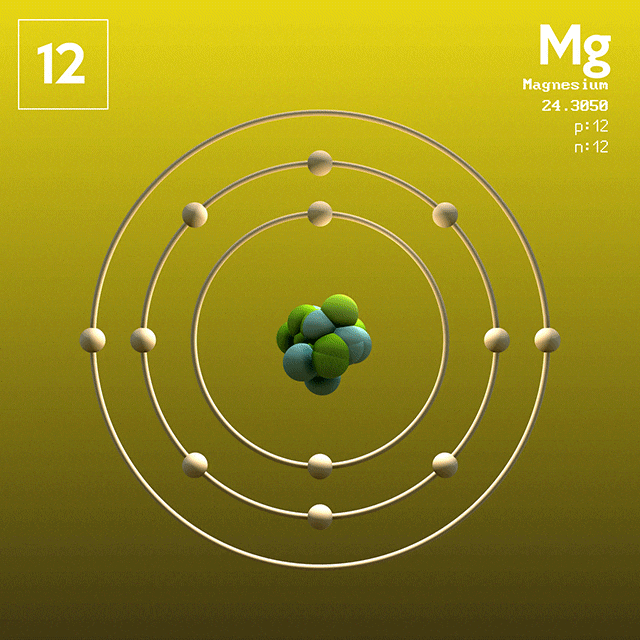Sore, Sleepy, and Stiff? Meet Magnesium, Your Muscle and Sleep MVP
One of the most common questions we get from patients is about which supplements are good for sleep/muscle pain/soreness. If there were an Olympic medal for underrated minerals, magnesium would be standing sheepishly on the podium, probably massaging someone else’s cramped calf.
Magnesium, the humble mineral, is responsible for over 300 enzymatic reactions in the body, and yet most of us don’t get enough. Why should you care? Magnesium may be the missing link in your quest for better sleep, fewer spasms, and less sore muscles after that heroic (if slightly impulsive) leg day.
Let’s unpack the magnesium mystery, focusing on the magnesium types that will help muscles, with a side of science and a sprinkle of sass.
Sleepy-Time Magnesium: The Calming Companions
Recommended Forms:
Magnesium glycinate – praised for gentle digestion and calming effects.
Magnesium L‑threonate – crosses the blood–brain barrier; supports deep & REM sleep.
Contraindications & Safety Notes:
Kidney concerns: If you have impaired renal function, magnesium (especially glycinate) can accumulate, risking hypermagnesemia. Dangerous levels can cause nausea, low blood pressure, irregular heartbeat, even arrest UPA MedTheHealthLines.comHealth.
Medication interactions:
Antibiotics (tetracyclines, fluoroquinolones) may bind with magnesium—reduce absorption. Keep ≥2–4 hours between doses UPA MedHealthekolhospitals.com.
Bisphosphonates (e.g., osteoporosis meds like alendronate/Fosamax) also compete with magnesium for absorption Healthekolhospitals.com.
Calcium channel blockers / antihypertensives: magnesium may further lower blood pressure—monitor for hypotension UPA Medsideeffectof.comekolhospitals.com.
Other medications: Diuretics, PPIs, diabetes drugs (e.g., metformin) may deplete or accumulate magnesium—requiring careful monitoring Healthekolhospitals.com.
Allergies & sensitivities: Rare, but possible. Watch for rash, swelling, itching, or breathing difficulties The Boobalamedreviewhub.com.
Pregnancy/breastfeeding: Safety data limited—consult your provider before supplementing medreviewhub.comSuppCoTheHealthLines.com.
Hormonal sensitivities: Anecdotal reports (e.g., in estrogen-sensitive breast cancer) suggest glycine (the "glycinate" moiety) might have hormonal activity. Preliminary in-vitro/animal data noted raised estrogen levels and cell-line growth—though this is speculative and not confirmed in humans. Discuss with your oncologist if applicable Reddit.
Magnesium for Muscle Soreness & Recovery
Magnesium helps with muscle recovery, boosting energy, calming inflammation, and muscle relaxation. Let’s break it down.
Magnesium plays a critical role in muscle function, energy production, inflammation modulation, and electrolyte balance. When you're sore, stiff, or cramping post-exercise, there's a good chance your magnesium levels are either depleted—or under pressure.
🧪 Why Magnesium for Muscle Recovery?
Magnesium helps muscles:
Relax after contraction (acts as a natural calcium channel blocker)
Reduce inflammation and oxidative stress
Regenerate ATP, your body’s cellular energy currency
Stabilize membranes and neuromuscular excitability (reduces spasms)
Athletes and active people lose magnesium through sweat and urine, especially during high-volume or high-intensity training. Even mild magnesium deficiency can result in:
Increased muscle cramps
Higher perceived exertion
Slower recovery time
More DOMS (Delayed Onset Muscle Soreness
Not all magnesium supplements are created equal. Here’s what science and clinical use say about the best ones:
1. Magnesium Glycinate
The Gentle Relaxer
Why it’s good: Combines magnesium with glycine, an amino acid with calming, anti-inflammatory effects.
Key perks:
High absorption
Less likely to cause diarrhea
Reduces muscle tension, promotes recovery during sleep
Ideal for: Active people with sleep issues, soreness, or tight muscles
Bonus: Glycine supports collagen synthesis and gut health
Rating: ⭐⭐⭐⭐⭐
Evidence: PMC3703169 (RCT on sleep/muscle relaxation); clinical use in fibromyalgia and muscle tension
Dose: 200–400 mg elemental magnesium/day
2. Magnesium Citrate
The All-Arounder
Why it’s good: Highly bioavailable and supports muscle recovery via anti-inflammatory and neuromuscular pathways.
Key perks:
Cost-effective
Supports ATP synthesis
Mild laxative effect can help with post-workout GI sluggishness
Watch out: Can cause loose stools if overdosed
Rating: ⭐⭐⭐⭐
Evidence: Used in studies with athletes, especially for fatigue and tension relief
Dose: 200–350 mg/day, split into 2 doses
3. Magnesium Malate
The Energy Booster
Why it’s good: Contains malic acid, which fuels the Krebs cycle (your body’s ATP-generating machine).
Key perks:
Reduces muscle pain, especially in fibromyalgia
Supports mitochondrial recovery
Non-sedating (daytime friendly)
Ideal for: Those with fatigue + soreness
Rating: ⭐⭐⭐⭐
Evidence: Russell et al., 1995 pilot study in fibromyalgia; clinical anecdotes suggest energy and pain support
Dose: 1,000–2,000 mg/day of magnesium malate (providing ~100–200 mg elemental Mg)
4. Magnesium Chloride (Topical)
The Skin Absorber (Maybe)
Why it’s good: Claimed to bypass the gut and go straight to sore muscles via transdermal absorption.
Used in: Magnesium oils, sprays, and Epsom salt (magnesium sulfate) baths
Evidence: Mixed. Some studies show skin absorption, others don’t.
Best for: Localized soreness or relaxation, especially post-exercise
Rating: ⭐⭐ (for science) ⭐⭐⭐⭐ (for placebo + feel-good factor)
Evidence: Lacks robust data, but subjective benefit reported
Use: 15–30 minutes in Epsom salt bath or 5–10 sprays on skin post-workout
5. Magnesium Taurate / Magnesium L‑Threonate
Special Mentions
Taurate: Supports cardiac muscle and calms the nervous system. May be helpful for endurance athletes with high cardiovascular demand.
L‑Threonate: Crosses the blood–brain barrier, best for cognitive recovery, not muscle-specific—but if mental fatigue is your soreness, it’s a win.
Ratings:
Taurate ⭐⭐⭐
L‑Threonate ⭐⭐ (for muscle recovery) ⭐⭐⭐⭐ (for mental fog)
🚫 Contraindications & Safety Notes
Kidney impairment: Same risk of magnesium buildup and toxicity HealthUPA MedTheHealthLines.com.
Drug interactions: Antibiotics, bisphosphonates, and blood pressure meds same as above—space dosages, consult physician EatingWellUPA MedHealth.
GI sensitivity: Though glycinate is gentler, high doses may still cause nausea, cramping, diarrhea—even affecting performance Healthvitafenixsupplements.comTheHealthLines.com.
Overlap with other minerals: High magnesium may disrupt calcium or zinc absorption—monitor dietary balance vitafenixsupplements.comZerodol SP.
Muscle Relaxation & Spasms
Theoretically helpful via calcium regulation and neuromuscular relaxation but evidence is mixed. These Magnesium types may overlap with helping with muscle recovery.
Let’s rank the magnesium supplements based on their effectiveness for relaxation, cramp reduction, and tolerability:
🥇 1. Magnesium Glycinate
The Gold Standard for Muscle & Nervous System Calm
Why it works: Glycine is a calming amino acid that acts on NMDA and GABA receptors—so this combo supports both muscle and nervous system relaxation.
Key benefits:
Highly absorbable
Non-laxative (gut-friendly)
Reduces muscle tension, spasms, and nighttime leg cramps
Best for: People with tightness, spasms, poor sleep, and stress-related muscle clenching.
Evidence:
Widely used in clinical practice for muscle tension, fibromyalgia, and anxiety-related muscle tightness.
Studies show magnesium improves sleep and reduces cortisol, indirectly helping tight muscles.
Rating: ⭐⭐⭐⭐⭐
Typical dose: 200–400 mg elemental magnesium per day
🥈 2. Magnesium Citrate
The Absorption All-Star
Why it works: Combines magnesium with citric acid, enhancing bioavailability and muscle uptake.
Key benefits:
Well-absorbed
Supports electrolyte balance
May reduce mild muscle cramps and spasms
Watch out: Can cause loose stools at higher doses.
Best for: General relaxation and mild spasms, especially if you’re prone to constipation too.
Evidence:
Found effective in studies for magnesium repletion and prevention of leg cramps in some populations.
Particularly helpful when cramping is due to magnesium deficiency.
Rating: ⭐⭐⭐⭐
Typical dose: 250–350 mg elemental magnesium daily
🥉 3. Magnesium Malate
The Energizer with a Pain-Relief Twist
Why it works: Malic acid supports mitochondrial energy production and may reduce muscle pain and tenderness.
Best for: Muscle spasms related to chronic fatigue, fibromyalgia, or low energy states.
More stimulating than glycinate or citrate—best taken earlier in the day.
Evidence:
Used successfully in fibromyalgia patients with muscle pain and fatigue.
Some pilot trials suggest improved muscle discomfort and trigger point sensitivity.
Rating: ⭐⭐⭐⭐
Typical dose: 1,000–2,000 mg magnesium malate (100–200 mg elemental Mg)
4. Magnesium Taurate
Cardio-Calm Muscle Aid
Why it works: Combines magnesium with taurine, an amino acid that supports calcium regulation, membrane stability, and nerve signaling.
Best for: Muscle spasms with an electrical or nerve component (e.g., arrhythmia, restless legs, palpitations)
Evidence:
Less studied specifically for muscle spasms, but taurine is known to stabilize membranes and reduce nerve excitability.
Rating: ⭐⭐⭐
Typical dose: 100–300 mg elemental magnesium
5. Topical Magnesium (Magnesium Chloride / Epsom Salt)
The Local Muscle Soother (Maybe)
Why it works: Magnesium absorbed through the skin might reduce localized soreness or cramping.
Epsom salt (magnesium sulfate) baths: anecdotal relief for sore or twitchy muscles.
Magnesium oil (chloride) sprays: popular for calves, neck, or shoulders.
Evidence:
Mixed. Some absorption may occur through skin—but the degree varies.
Most users report subjective relief, even if not strongly supported in large-scale trials.
Rating: ⭐⭐½
Best for: Targeted relief, post-workout recovery
⚠️ Contraindications & Cautions
All points apply as above—particularly for individuals on heart/blood pressure meds or with renal compromise.
No specific extra contraindications beyond general magnesium considerations.
***As a good reminder, this blog post is not a short-cut and should not be used to bypass seeking guidance from your healthcare provider. This isn’t a one size fits all. Be sure to check with your provider before beginning any supplementation. ***
👋 Final Thought
If your muscles are overworked, cramping, or constantly whispering, “please stretch me,”—magnesium might be the support you didn’t know you needed.
Remember: if magnesium works, it’s often because you were deficient in the first place, so it's worth testing or tracking your intake through diet and labs if symptoms persist.





